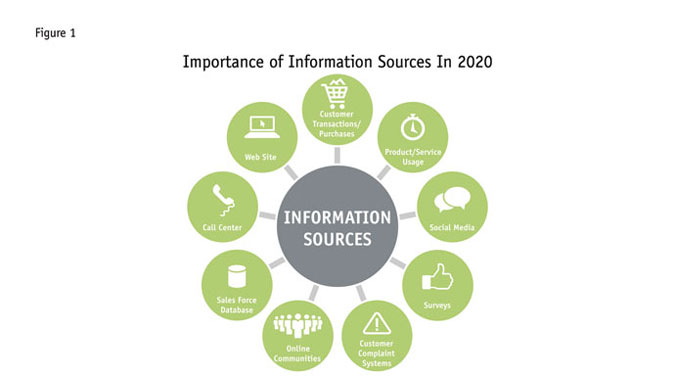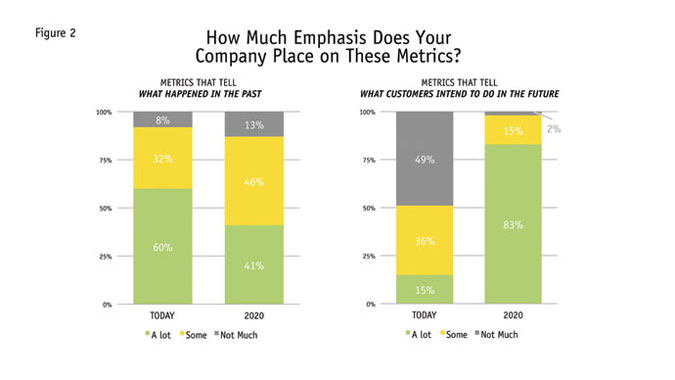Tomorrow is closer than you think
Editor's note: Leslie Pagel is vice president, customer experience at Walker Information, an Indianapolis customer intelligence consulting firm.
The year 2020. In saying it, we tend to picture a time much further in the future. Customers today already know more and expect more. Fast-forward six years and there’s little doubt the bar will be set even higher and new priorities will have emerged.
So, who will win in 2020? Arguably, it will be the most forward-thinking companies – those that consciously and deliberately work at anticipating the future needs of their customers and devise strategies to deliver. The winners of 2020 are those who begin preparing today.
To better understand those strategies and reveal a clearer picture of what B2B customer experience will look like in the not-too-distant future, our firm, Walker Information, an Indianapolis customer intelligence consulting firm, collaborated with CustomerThink and the Chief Customer Officer Council to conduct a robust study, Customers 2020, which included in-depth interviews, roundtable discussions and an online survey. Walker collected and synthesized input from nearly 300 customer experience professionals from large, multinational business-to-business organizations, representing a range of industries.
Our research incorporated several initiatives:
-
In October 2012, Walker conducted roundtable discussions with 31 business leaders and customer experience professionals. Their views reflect large, global B2B companies from a range of industries.
-
In-depth interviews with 35 executives, including CEOs, executive vice presidents and senior directors were conducted to explore the common themes that emerged from the roundtable discussions. The discussions focused on how customer expectations are likely to change in 2020, what companies need to do to meet customer needs in the future and how customer experience professionals must evolve.
-
A quantitative survey was conducted with 204 customer experience professionals to validate the findings from the in-depth discussions. They represent a range of industries, company size and titles with responsibilities for supporting the development of customer strategies.
-
Findings were reviewed with a panel of chief customer officers for validation.
Three expectations
There is no denying that customer expectations are changing. There are three expectations that B2B customers will demand from those they choose to do business with.
1. There will be no room for strangers.
What we mean by this: Well-informed customers will want to do business with companies that know them and their business intimately, have a clear understanding of where it’s headed and can design an experience that meets their needs.
What companies must do: As customers demand a more personalized experience, companies will be forced to learn more about the customer and integrate this knowledge into the experiences that customers have with the product and services.
2. Immediate gratification is not fast enough.
What we mean by this: The speed of innovation continues to accelerate, shortening the product life cycle. Customers no longer buy products that withstand decades. They buy products and expect them to be updated as their needs evolve.
What companies must do: Being proactive isn’t just about R&D or product development. In order to retain customers, companies must continually anticipate needs at each stage of the customer life cycle and proactively respond. It relates to every aspect of the customer journey. In the most agile and prepared companies, marketing will seek to anticipate the future needs of the market to craft branding strategies and campaigns that create awareness. Sales teams will seek to know where their customers are headed and anticipate what they’ll need in the short term and long term to deliver client success. Customer service will need to know enough about the customer to anticipate issues and proactively engage in a resolution.
In addition, the metrics that companies use will evolve too. Today, companies put a great deal of emphasis on metrics, such as operational or financial data, that explain what happened in the past. While these descriptive metrics will continue to be important, to anticipate future needs, companies will place greater emphasis on more predictive metrics that come from forecasting and predictive analytics.
3. Customers will want to interact on their own terms.
What we mean by this: Customers will want to do business with companies that provide a consistent, informed and superior experience across all channels of communication, taking into consideration that customers will have different preferences. Customers will expect to interact using their preferred method.
What companies must do: Complexities inevitably exist in managing different methods of interaction. Information must be consistent across channels to meet customer needs. Companies need to enable communication across an increasing number of platforms and ensure a consistent experience regardless of how the customer chooses to communicate.
Require new skills
So, what do customer experience professionals need to do now? Nearly every facet of the customer experience function will expand, bringing more transparent evidence of value and more precise direction for driving results throughout the enterprise. The scope of the customer experience professional will broaden in the coming years. More and different responsibilities will require new skills and people to accomplish the necessary tasks:
Chief customer champion.Regardless of title, there must be someone in the organization – reporting to the CEO or another top executive – charged with creating a relentless focus on the customer throughout the enterprise. His or her primary objective is to drive customer retention, growth and profitability by creating engaged customers. The chief customer champion will lead cross-functional teams focused on prioritizing customer initiatives, aligning the right resources to priority areas, tracking the execution of plans and implementing change that improves company performance. The champion will also manage resources that are focused on creating an infrastructure to support awareness, understanding and use of customer intelligence throughout the enterprise.
Information architect. To ensure the effective use of customer-focused metrics throughout the enterprise, IT support will be needed for two activities: to align disparate sources of customer information and to create an infrastructure for enterprise-wide accessibility. While this resource might not report directly to the chief customer champion, the champion will have the authority to influence IT-related initiatives. Therefore, the champion should maintain a close relationship with the CIO.
Data scientist. Data scientists will lead the way in determining how companies can best leverage multiple sources of information to predict customer behaviors and perceptions and will work with subject-matter experts to use these predictions to prescribe action. Turning big data and predictive analytics into practical and useful sources will be the charge of the data scientist.
Top account support. In the B2B world, strategic accounts deserve to be treated as high priority. The chief customer champion will play a key role in this by ensuring the organization understands the unique needs of its top accounts and has the right support ecosystem to build trust and loyalty at every level of the organization. These resources will share customer intelligence related to individual accounts, will review account plans to ensure customer needs are addressed and will track the execution of account plans. In addition, because this resource will have oversight of top accounts, they will share best practices and approaches that have been used and will look for systemic issues across top accounts.
Engagement creator. Getting and keeping customers engaged will be a strategic initiative for B2B companies in the future and companies should plan to assign resources to develop this engagement. The role of the engagement creator will deliver two primary benefits. First, customer engagement and collaboration will help prioritize and guide strategic initiatives resulting in greater return. Second, by connecting customers with each other, they will share best practices and offer support, lowering the cost-to-serve and increasing the value customers receive.
Evolve to meet customer needs
What gets measured gets managed and what is being measured today will evolve to meet customer needs of the future. Today, many customer-focused metrics such as Net Promoter, satisfaction and loyalty are narrowly focused on solicited feedback from surveys. While solicited input will continue to be used, companies will progress to include a more holistic measurement of customer engagement.
As 2020 approaches, companies will look for a way to tie all of their customer information, no matter where it comes from (Figure 1), together into a clear, understandable measurement of customer engagement. In addition, as shown in Figure 2, more and more companies will seek customer metrics that predict future behaviors for all customers, not just those filling out surveys.


We believe a customer engagement metric will soon begin playing a significant role in demonstrating the value of customer experience initiatives and ultimately will be viewed at the highest levels as a leading indicator of growth.
Unlike most metrics today that solely rely on one dimension of the customer experience, customer engagement will seek to measure a more holistic view of the customer. While it will be highly customized to reflect the unique customer strategy and business objectives, it will include four common elements:
Product usage: Companies will want to monitor and explore from all angles how customers use their products. Data that will be helpful will include things such as the range of products purchased or installed, the extent to which the product is being fully utilized and the number of people engaged with the product.
Sentiment: Sentiment includes the feelings and attitudes that customers hold and considers things such as how often the customer provides feedback and the magnitude of their feelings. Of course surveys are one source of customer sentiment but companies should consider other sources, such as input from frontline associates, social media and customer advisory councils.
Involvement: Companies should look at the ways a customer participates in the firm’s business. The emphasis on involvement is customer activity, independent of their thoughts and feelings. Involvement includes things such as a customer’s willingness to share a case study, be a reference or give a referral, follow the company on social media sites and collaborate or co-create solutions.
Competitive position: Likely the most difficult for companies to gather, competitive position considers how engaged the customer is with other alternatives in the market. It seeks to understand share-of-wallet, the degree of difficulty involved in replacing or substituting products and customer preference for all companies in the marketplace.
(One of the findings from Customers 2020 was that “ease of doing business” is a top priority for customers. In fact, a recent study found that six out of 10 CX professionals believe simplifying products would have the higher impact on customer loyalty than any other improvement. What’s more, it is estimated that ease of doing business is a top driver of loyalty for more than 75 percent of B2B companies. Recognizing the potential business impact, Walker conducted a new study, titled The Value of Making it Easy, which focuses on helping customer experience leaders be the catalyst for change in streamlining procedures and simplifying processes for customers and partners.)
Difficult to harness
There are pieces of customer information lurking in every area of today’s companies. Without a collective view and purpose, organizations within enterprises gather customer information based on their own individual needs. This volume of data is difficult to harness and in many cases, companies don’t have a complete accounting of all the information that’s available. Additionally, many companies are overloaded with static data incapable of offering predictive value for the future.
As the tsunami of data continues to grow, companies are asking themselves, “How do we use this data to create meaningful insights that give us a competitive advantage?” Studies such as Customers 2020 provide guidance for how to answer this and other critical questions.
